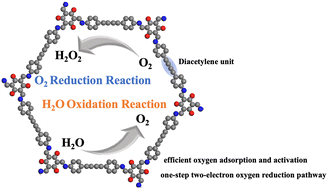A diacetylene covalent organic framework through a one-step two-electron O2 reduction pathway for efficient photosynthesis of H2O2†
Abstract
A one-step two-electron oxygen reduction pathway is crucial for the stable and efficient photosynthesis of hydrogen peroxide. However, the lower oxygen adsorption and activation capacity significantly restrict the ability of the one-step two-electron oxygen reduction pathway. In this work, a covalent organic framework containing a diacetylene unit (COF-Tfp-BDDA) as an efficient oxygen reduction active site was designed for the photosynthesis of hydrogen peroxide. This work demonstrates that the introduction of the diacetylene unit efficiently improved the oxygen adsorption and activation capacity of the COF. Additionally, the introduction of a diacetylene unit effectively promoted charge separation. COF-Tfp-BDDA exhibited a superior rate of H2O2 preparation (880 μmol g−1 h−1) under visible light irradiation from pure water and oxygen, better than most COF-based photocatalysts. The catalyst exhibited a stable hydrogen peroxide photosynthesis efficiency above 100 hours in cycling experiments. Based on the experimental and DFT calculation results, the introduction of a diacetylene unit not only enhances the adsorption and activation of oxygen but also alters the reduction pathway of oxygen, leading to effective charge separation. These factors contribute to the efficient photosynthesis of hydrogen peroxide in pure water. This work provides a novel idea regarding the application of COFs in the field of solar energy conversion.



 Please wait while we load your content...
Please wait while we load your content...